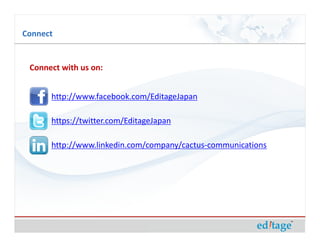适切な研究课题の设定が论文掲载の第一歩
- 1. 适切な研究课题の设定が论文掲载の第一歩 Helping you get published
- 2. 适切な研究课题の设定が论文掲载の第一歩 論文を執筆するときの最も重要な第一ステップは : 1. 学問を進歩させるようなトピックを選択する 2. 科学と人類の研究に新たな基本的構成要素を付 け加える 研究課題の良くない論文をジャーナルの編集者が 受理することは原則的にほとんどありません。
- 3. 适切な研究课题の设定が论文掲载の第一歩 研究課題が明確に定義されていれば、研究者はよ り明晰な研究計画の展開、研究デザイン、データ分 析ができるので、掲載の可能性も必然的に高くなり ます。1,2 はっきり定義付けられた研究課題はジャーナルの 編集者や査読者にも良い第一印象を与えます。反 対に不明確な研究課題の論文は、その研究が慎重 に検討されたものではないという認識を与えるので 受理の可能性を下げる原因になります3。
- 4. 适切な研究课题の设定が论文掲载の第一歩 1本の論文で1つ以上の研究課題を扱うこともでき ますが、一般的には1つの一番重要な研究課題に 焦点を当てて書くことをおすすめします 3。 それでは、「よい研究課題」とは何でしょうか。 論文のタイプや学問分野の違いによって答えは様 々ですが、あなたがシェイクスピアについて、幹細 胞について、もしくはスチール加工について執筆し ていたとしても、念頭に置くべき共通の基準があり ます。
- 5. 适切な研究课题の设定が论文掲载の第一歩 だから何なのか。 どんな研究課題も、この「だから何なのか」という問いをパスしなければなりません4。 どんな研究課題も、この「だから何なのか」という問いをパスしなければなりません 1. 自分の研究課題に対してこの質問を問いかけてみて出てくる答え は、興味深く重要で、有意義なものでしょうか。 2. 研究で得られそうな成果を見定めたら、常に「だから何なのか」と自 分自身に問いかけましょう。
- 7. 适切な研究课题の设定が论文掲载の第一歩 例えば「優れた外科医の指は長い傾向にあるか」 「優れた外科医の指は長い傾向にあるか」と 「優れた外科医の指は長い傾向にあるか」 いう研究課題は、有意義な知識にはなりそうにあり ません。 一方で、「研修医に対する手先の器用さのテストは 「研修医に対する手先の器用さのテストは 外科手術のパフォーマンスを予測するか」という課 外科手術のパフォーマンスを予測するか」 題ならば、医療訓練の専門家による外科手術の技 量訓練プログラムの改善に役立つでしょう。
- 8. 适切な研究课题の设定が论文掲载の第一歩 非自明性 斬新ではない研究結果、言い換えれば新奇性の なさは、ジャーナルが論文をリジェクトする際に最 もよくある理由です。科学ジャーナルの編集者たち は新奇性 非自明性 新奇性と非自明性 新奇性 非自明性を重んじます。つまり、研究 課題は既に自明な解答を提示するべきものではな いのです4,5。
- 9. 适切な研究课题の设定が论文掲载の第一歩 非自明性 投稿論文の90%をリジェクトするジャーナルもあ り、確実にあなたの論文が傑出していて次のい あなたの論文が傑出していて次のい ずれかの価値付けがされていることが重要で ずれかの価値付けがされていることが重要 す6。 1. 実社会に応用可能、もしくはさらに進んだ研究 の方向性を含む新情報を提示している 2. 既存情報を裏付けし、一般化可能性や応用性 が拡張される 3. 既に文献に記載されている内容を否定する研 究結果を提供しているか、注意深く再考し分析 している 。
- 10. 适切な研究课题の设定が论文掲载の第一歩 複製(レプリケーション)は容認される???時々は 全ての論文が完全に未知の情報を提供しているわけでは ありません。例えば、他の研究者たちの観察記録が再現 可能なのか(特に観察記録に議論の余地があったり説得 力に欠けたりしていたが、重要な場合)や、ある集団に関 する研究結果がその他にも適用できるのかを知ること、あ るいは新しい方法論を利用して既知の関連性を明確にし たりすることは興味深いかもしれません。また、他の研究 者たちによる研究結果を、彼らの限界を取り払い確証付 ける研究もとても有益です7 。 もしあなたの研究結果が以上3つの必要条件を満たして いるようであれば、おそらくあなたは価値ある研究課題を 見つけたのでしょう。
- 11. 适切な研究课题の设定が论文掲载の第一歩 よい研究課題を見つけ明確にするためのコツ 臨床や実践経験は、自分の研究の興味と同じぐら い研究の方向を定める上で大事なのは言うまでもあ りません。同時に先行研究の十分な調査をして、自 分の課題が的外れにならないよう確かめるのも欠 かせない作業です。 他の誰かが既に研究したことをそっくりなぞることを 避けるためにも、その分野での最新情報を仕入れ ておきましょう。近頃ではとてつもない量の研究成果 ておきましょう。 が生み出されているので、これはありえない話では ありません。
- 12. 适切な研究课题の设定が论文掲载の第一歩 よい研究課題を見つけ明確にするためのコツ 先行研究を調べることから自分の研究課題を新た に見つけられることもあります。たとえば、論文のな かでも議論のセクションは、未解決の課題や、追加 実験や今後可能性のある研究についてよく言及さ れています。とくに、誰かの研究の結論やその推論 が多くの異論を呼んでいるという場合、その研究を 反復してみて、その結果が正当だと検証することも できます4。つまり、よい研究課題は、先行研究に違 和感や説得力の弱さを認めたときに生まれてくるわ けです。
- 13. 适切な研究课题の设定が论文掲载の第一歩 よい研究課題を見つけ明確にするためのコツ よい研究課題を見つけるための方法はたくさんあり ます。学会や研究会に出席するのもそのひとつです 。特定の分野の最新情報は学会で発表されることが 多く、その分野で活躍する研究者から、論文が出版 される前に最新の研究成果を直接聞くことができま す7。このように、学会への参加や分野でのネットワ ーキングは自分自身の研究に価値のある手段とな ることがあります。科学研究費制度による研究者募 集をみて、科研費採択の可能性の高い研究アイディ アを知ることもできます。
- 14. 适切な研究课题の设定が论文掲载の第一歩 よい研究課題を見つけ明確にするためのコツ 研究者がその段階と事情に応じて研究課題を定め ることを目的に開発された、PICOT、PESICO、FINER3,8 、 、 といったフレームワークがあります。これらのテンプ レートを利用し、研究者、特に初心者の研究者は確 立された方式でのブレインストーミングや、研究課題 の確定に役立ててください。
- 15. 适切な研究课题の设定が论文掲载の第一歩 PICOT: Population, Intervention, Control, Outcome, Time Frame PESICO: Person/problem, Environments, Stakeholders, Intervention, Compar ison, Outcomes FINER: Feasible, Interesting, Novel, Ethical, Relevant SPICE: Setting, Population, Intervention, Comparison, Evaluation
- 16. 适切な研究课题の设定が论文掲载の第一歩 PICOTを使った研究課題の組み立て方 を使った研究課題の組み立て方 Source: Thabane et al. (2009)3
- 17. 适切な研究课题の设定が论文掲载の第一歩 PICOTを使った研究課題の組み立て方 を使った研究課題の組み立て方 Person/ Environment Stakeholders Intervention Comparison Outcomes Problem (P) (E) (S) (I) (C) (O) In a 10-year old who is currently whose what strategy is as compared to in terms of child with attending a self- interdisciplinary most effective or other strategies expressive developmental contained support team has efficient for signing, and/or disabilities and classroom and determined to introducing expressive little or no part-time target manual manual signs natural speech, functional speech included in signing as an and/or receptive but good fine- regular class appropriate speech? motor skills activities mode of communication Source: Schlosser, Koul, & Costello (2007)8
- 20. 适切な研究课题の设定が论文掲载の第一歩 参考文献: 参考文献 1. Sackett DL & Wennberg JE (1997). Choosing the best research design for each question. BMJ, 315: 1636. [Publisher] 2. Stone P (2002). Deciding upon and refining a research question. Palliative Medicine, 16: 265–7. 3. Thabane L, Thomas T, Ye C, Paul J (2009). Posing the research question: Not so simple. Canadian Journal of Anaesthesia, 56(1): 71-9. doi: 10.1007/s12630-008-9007-4. 4. Kwiatkowski T & Silverman R (1998). Research fundamentals: II. Choosing and defining a research question. Academic Emergency Medicine,5(11): 1114-7. 5. Ali J (2010). Manuscript rejection: causes and remedies. Journal of Young Pharmacists, 2(1): 3-6. doi: 10.4103/0975-1483.62205.
- 21. 适切な研究课题の设定が论文掲载の第一歩 参考文献: 参考文献 6. Cook C, Brismée J-M, Courtney C, Hancock M, May S (2009). Publishing a scientific manuscript on manual therapy. The Journal of Manual & Manipulative Therapy, 17(3): 141- 7. 7. Cummings SR, Browner WS, & Hulley SB (2006). Conceiving the research question. Designing Clinical Research, Third Edition, pp. 17-23. Wolters Kluwer Health: Philadelphia. 8. Schlosser RW, Koul R, Costello J (2007). Asking well-built questions for evidence-based practice in augmentative and alternative communication. Journal of Communication Disorders, 40(3): 225-38. doi: 10.1016/j.jcomdis.2006.06.008. 9. Pierson DJ (2004). The top 10 reasons why manuscripts are not accepted for publication. Respiratory Care, 49(10), 1246-52.
- 22. Connect Connect with us on: http://www.facebook.com/EditageJapan https://twitter.com/EditageJapan http://www.linkedin.com/company/cactus-communications

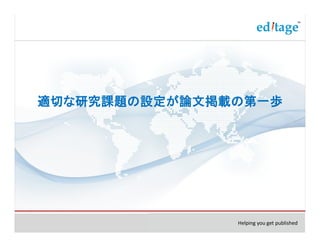
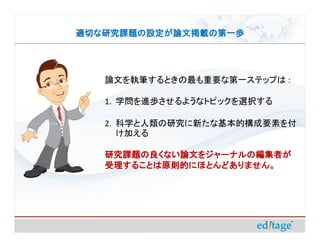

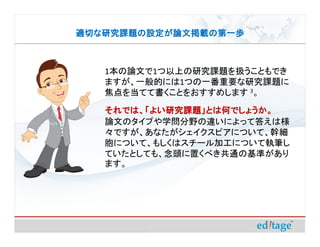


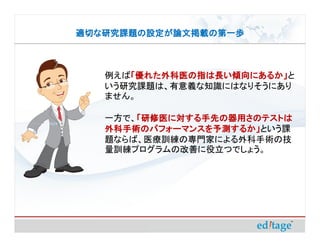

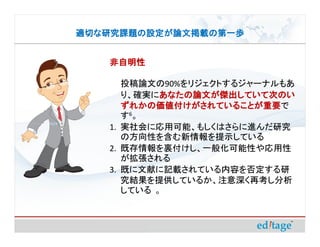
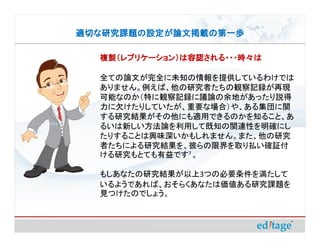
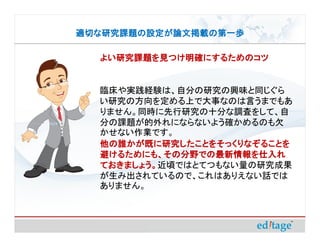
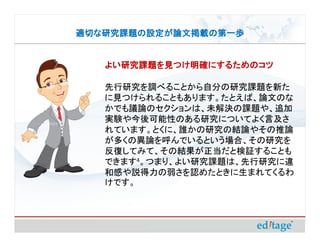
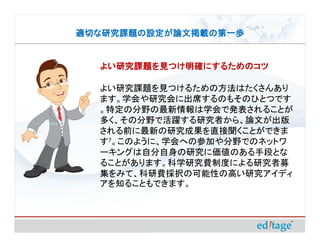
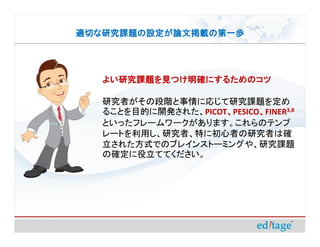
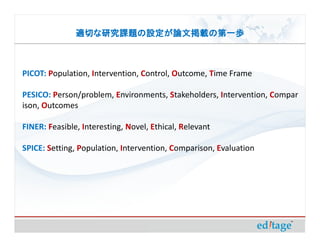
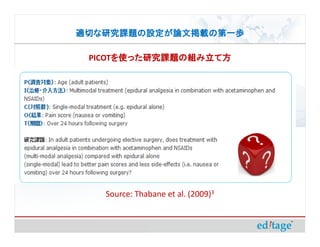

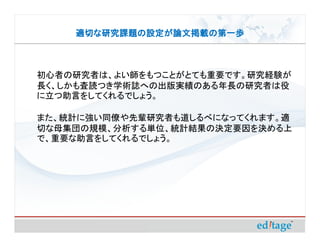
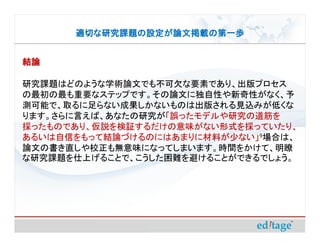
![适切な研究课题の设定が论文掲载の第一歩
参考文献:
参考文献
1. Sackett DL & Wennberg JE (1997). Choosing the best research design for each question.
BMJ, 315: 1636. [Publisher]
2. Stone P (2002). Deciding upon and refining a research question. Palliative Medicine, 16:
265–7.
3. Thabane L, Thomas T, Ye C, Paul J (2009). Posing the research question: Not so simple.
Canadian Journal of Anaesthesia, 56(1): 71-9. doi: 10.1007/s12630-008-9007-4.
4. Kwiatkowski T & Silverman R (1998). Research fundamentals: II. Choosing and defining a
research question. Academic Emergency Medicine,5(11): 1114-7.
5. Ali J (2010). Manuscript rejection: causes and remedies. Journal of Young Pharmacists, 2(1):
3-6. doi: 10.4103/0975-1483.62205.](https://image.slidesharecdn.com/1-findingtherightresearchquestionisthefirststeptosuccessfulpublication-120409014847-phpapp02/85/-20-320.jpg)

